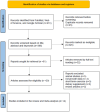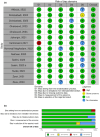Systematic review and meta-analysis of the effect of exercise training on asprosin in randomized controlled trials
- PMID: 40515432
- PMCID: PMC12166126
- DOI: 10.14814/phy2.70392
Systematic review and meta-analysis of the effect of exercise training on asprosin in randomized controlled trials
Abstract
Asprosin, a protein that enhances insulin resistance by stimulating hepatic glucose secretion, is linked to obesity, metabolic disorders, and cardiovascular diseases. This systematic review and meta-analysis investigate the influence of exercise training (ET) on circulating concentrations of asprosin. A systematic search of PubMed, Web of Science, and Google Scholar databases was conducted for all randomized controlled clinical trials from January 2016 to November 2024. A total of 431 relevant articles were retrieved and screened according to the study population, intervention method, and study type, resulting in the selection of 14 articles for the meta-analysis. All statistical results were analyzed using Comprehensive Meta-Analysis Software version 2 (CMA2). The overall effect size, using Hedges' g, based on the random effects model for asprosin with ET, was -1.70 (95% CI -2.17 to -1.23, p = 0.0001). A decrease in asprosin concentration was observed with all types of ET including aerobic training (AT, H = -1.71, p = 0.0001), high-intensity interval training (HIIT, H = -1.81, p = 0.001), and resistance training (RT, H = -1.62, p = 0.0001). Furthermore, subgroup analysis showed differences in asprosin based on body mass index (Q-value = 11.09, df = 2, p = 0.004) and health status of the subjects (Q-value = 12.64, df = 2, p = 0.002); however, there were no differences based on sex (p = 0.67), types (p = 0.96), and duration (p = 0.34) of training. Our findings suggest that ET is associated with a decrease in circulating asprosin that could have a beneficial effect in preventing metabolic disease that is enhanced with obesity. Systematic review registration PROSPERO: CRD42023468813.
Keywords: asprosin; exercise training; high‐intensity interval training; obesity.
© 2025 The Author(s). Physiological Reports published by Wiley Periodicals LLC on behalf of The Physiological Society and the American Physiological Society.
Conflict of interest statement
The authors declare that they have no competing interests.
Figures









Similar articles
-
Physical exercise training interventions for children and young adults during and after treatment for childhood cancer.Cochrane Database Syst Rev. 2016 Mar 31;3(3):CD008796. doi: 10.1002/14651858.CD008796.pub3. Cochrane Database Syst Rev. 2016. PMID: 27030386 Free PMC article.
-
Systemic pharmacological treatments for chronic plaque psoriasis: a network meta-analysis.Cochrane Database Syst Rev. 2021 Apr 19;4(4):CD011535. doi: 10.1002/14651858.CD011535.pub4. Cochrane Database Syst Rev. 2021. Update in: Cochrane Database Syst Rev. 2022 May 23;5:CD011535. doi: 10.1002/14651858.CD011535.pub5. PMID: 33871055 Free PMC article. Updated.
-
Drugs for preventing postoperative nausea and vomiting in adults after general anaesthesia: a network meta-analysis.Cochrane Database Syst Rev. 2020 Oct 19;10(10):CD012859. doi: 10.1002/14651858.CD012859.pub2. Cochrane Database Syst Rev. 2020. PMID: 33075160 Free PMC article.
-
Interventions for promoting habitual exercise in people living with and beyond cancer.Cochrane Database Syst Rev. 2018 Sep 19;9(9):CD010192. doi: 10.1002/14651858.CD010192.pub3. Cochrane Database Syst Rev. 2018. PMID: 30229557 Free PMC article.
-
Direct-acting antivirals for chronic hepatitis C.Cochrane Database Syst Rev. 2017 Sep 18;9(9):CD012143. doi: 10.1002/14651858.CD012143.pub3. Cochrane Database Syst Rev. 2017. PMID: 28922704 Free PMC article.
References
-
- Akbulut, T. , Cinar, V. , Ugur, K. , Yardim, M. , Karagoz, Z. , & Aydin, S. (2022). Effect of regular exercise on the levels of subfatin and asprosin: A trial with different types of exercise. European Review for Medical and Pharmacological Sciences, 26(8), 2683–2691. - PubMed
-
- Borenstein, M. (2022). Comprehensive meta‐analysis software. In Systematic reviews in health research: meta‐analysis in context (pp. 535–548). Wiley.
-
- Ceylan, H. İ. , Öztürk, M. E. , Öztürk, D. , Silva, A. F. , Albayrak, M. , Saygın, Ö. , Eken, Ö. , Clemente, F. M. , & Nobari, H. (2023). Acute effect of moderate and high‐intensity interval exercises on asprosin and BDNF levels in inactive normal weight and obese individuals. Scientific Reports, 13(1), 7040. - PMC - PubMed
-
- Chung, Y. L. , & Rhie, Y.‐J. (2022). Metabolic syndrome in children and adolescents. The Ewha Medical Journal, 45(4), 13–26.
Publication types
MeSH terms
Substances
LinkOut - more resources
Full Text Sources
Medical
Miscellaneous

